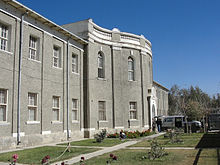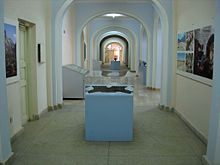- National Museum of Afghanistan
-
Coordinates: 34°28′03″N 69°07′12″E / 34.4675°N 69.12°E The National Museum of Afghanistan (Persian: موزیم ملی افغانستان, Muzem-e milli-ye Afghanistan), also known as the Afghan National Museum or the Kabul Museum, is a two-story building located 9 km southwest of the center of Kabul City in Afghanistan. It was built in 1922 during the reign of King Amanullah Khan.[1] The collection inside the museum was transfered from another location in the city and began as a 'Cabinet of Curiosities' in 1919.[2] In 1973, a Danish Architect was hired to design a new building for the museum, but the plans were never carried out due to political instability.[3]
Its collection had earlier been one of the most important in Central Asia[4], with over 100,000 items dating back several millennia. After the collapse of President Najibullah's government and during the start of the civil war in the early 1990s, the museum was looted numerous times resulting in a loss of 70% of the 100,000 objects on display.[5] In 1989, the Bactrian Gold was moved to an underground vault at the Central Bank of Afghanistan.[5]
In March 1994, the museum, which had been used as a military base, was struck by rocket fire and largely destroyed. The Ministry of Information and Culture of President Rabbani's government ordered that the 71 museum staff begin moving the inventory to Kabul Hotel in order to rescue them from further rocketing and shelling.[3] In September 1996, staff at the museum completed the cataloging of the remaining materials.[4] Between 2003 and 2006, about $350,000 were spent to refurbish the building. Fortunately, many of the most precious objects had been sealed in metal boxes and removed for safety and were recovered and inventoried in 2004.[6] Some archeological objects were found in vaults in Kabul,[7] while a collection was also discovered in Switzerland.[8]
Contents
Collections
Many treasures of ivory are stored there, as are antiquities from Kushan, early Buddhism, and early Islam. One of the most famous pieces in the museum, and known to have survived the turbulent period in the 1990s is the Rabatak Inscription of King Kanishka.
Archaeological Materials
As the National Museum Kabul has been the repository for many of the most spectacular archaeological finds in the country. These include the painted frescos from Dilberjin; inscriptions, fragments of architecture, sculpture, metal objects, and coins rescued from the French excavations at Ai-Khanoum and Surkh Kotal; the spectacular collection of objects found at a merchants warehouse in the city of Begram, which include ivories from India, mirrors from China, and glassware from the Roman Empire; the stucco heads of Hadda; Buddhist sculpture from Tepe Sardar and other monastic institutions in Afghanistan; and a large collection of Islamic art from the Ghazvanid and Timurid periods found at Ghazni.[9]
Numismatic Collection
The numismatic collection of the Museum has never been catalogued of published. Individual parts of the collection which were recovered in archaeological context have been published by the original excavators. DAFA (Delegation Archaeologie Francais Afghanistan) published the coin finds made at the town of Surkh Kotal. Some of the coins found at the excavation of Begram have been published.[10] Part of the Mir Zakah hoard, a very unusual deposit containing enormous numbers of coins from the fourth century BC to third century AD, totalling 11,500 silver and copper coins were kept in the museum. Part of the hoard was published by DAFA.[11] The museum has appointed a curator for Numismatics but the collection remains closed to scholars and the general public.[12]
The travelling collection
Certain important parts of the collection, including material from Begram, Ai Khanum, Tepe Fullol, and the gold jewellry from all six of the excavated burials at Tillya Tepe, have been on travelling exhibition since 2006. They have been exhibited at the Guimet Museum in France, Four museums in the USA, the Canadian Museum of Civilization, the Bonn Museum in Germany, and most recently to the British Museum. They continue to tour and will eventually return to the National Museum.[13]
See also
References
- ^ Afghanistan: Hidden Treasures from the National Museum, Kabul (2008), p. 35. Eds., Friedrik Hiebert and Pierre Cambon. National Geographic, Washington, D.C. ISBN 978-1-4262-0374-9.
- ^ Meharry, Joanie The National Museum of Afghanistan: In Times of War, The Levantine Review, http://www.levantinecenter.org/arts/cultures/central-asia/afghan/national-museum-afghanistan-times-war
- ^ a b Grissmann, Carla (February 19, 2004). "KABUL MUSEUM". In Ehsan Yarshater. Encyclopædia Iranica (Online Edition ed.). United States: Columbia University. http://www.iranicaonline.org/articles/kabul-museum.
- ^ a b Girardet, Edward and Jonathan Walter, eds., ed. Afghanistan. Geneva: CROSSLINES Communications, Ltd.. p. 291.
- ^ a b Lawson, Alastair (1 March 2011). "Afghan gold: How the country's heritage was saved". BBC. http://www.bbc.co.uk/news/world-south-asia-12599726. Retrieved 1 March 2011.
- ^ Afghanistan: Hidden Treasures from the National Museum, Kabul (2008), pp. 37-53. Eds., Friedrik Hiebert and Pierre Cambon. National Geographic, Washington, D.C. ISBN 978-1-4262-0374-9.
- ^ Priceless Afghan Treasures Recovered | NPR
- ^ "Afghan treasures return to Kabul". BBC News. 17 March 2007. http://news.bbc.co.uk/1/hi/world/south_asia/6462433.stm.
- ^ Tissot, F (2006) Catalogue of the National Museum of Afghansitan 1931-1985, UNESCO Publishing
- ^ Ghrishman, 1946
- ^ Curiel, R and Schlumberger, D (1953) Tresors Monetaires D'Afghanistan MDAFA XIV: 65-97
- ^ Journal of the Oriental Numismatic Society, No.207
- ^ Cambon, P Afghanistan les tresors retrouves, Paris 2007
External links
- Hidden Treasures from the National Museum, Kabul | National Geographic
- Gold Exhibit
- The National Museum of Afghanistan: In Times of War by Joanie Meharry
- Kabul Museum
- The Pillage of Kabul Museum
- Museum Under Siege by Nancy Hatch Dupree
- "Lost" Afghan Treasures Found
- Association for the Protection of Afghan Archeology
Capital 
Districts Bagrami · Chahar Asyab · Deh Sabz · Farza · Guldara · Istalif · Kabul · Kalakan · Khaki Jabbar · Mir Bacha Kot · Mussahi · Paghman · Qarabagh · Shakardara · SurobiCities Bagrami · Qalai Naeem · Tarakhel · Dehnawe Farza · Guldara · Istalif · Kabul · Kalakan · Khak-i Jabbar · Mir Bacha Kot · Mussahi · Paghman · Qara Bagh · Shakar Dara · SurobiLandmarks Darul Aman Palace · Abdul Rahman Mosque · Bala Hissar · Gurdwara Karte Parwan · InterContinental Hotel · Kabul's Irish Pub · Kabul Library · National Museum of Afghanistan · Pul-e Khishti Mosque · Safi Landmark Hotel · Shah-Do Shamshira MosqueCategories:- Museums in Afghanistan
- Buildings and structures in Kabul
- 1922 architecture
Wikimedia Foundation. 2010.


